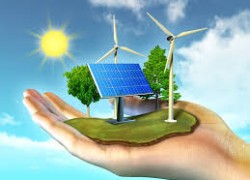
The EU-funded HYDROSOL-PLANT project supported by the Fuel Cells and Hydrogen Joint undertaking (FCH JU) has developed a technology that has the potential to produce hydrogen on a large-scale, cost-effectively. This renewable energy could slow climate change and create a sustainable future. The reason for this innovation is that Europe relies on natural gas and fossil fuels from a limited number of countries. These energy sources generate harmful greenhouse gases that accelerate climate change and its devastating impacts.
We are all part of the result of climate change – widely believed to be caused by CO2 emissions – with 2015 recorded as the hottest year in history. Unless we start relying on renewable energy instead of fossil fuels because the impact of climate change will simply get worse. “We need to intensify our efforts and investments into the R&D of renewable energy now before it’s too late,” says HYDROSOL-PLANT project coordinator Athanasios Konstandopoulos.
“Unfortunately, there is less of a financial and political incentive to develop alternative clean and renewable fuels because of the low price of natural gas and oil,” he explains. The production of green hydrogen is the answer to these complex environmental, geopolitical and economic challenges.” The HYDROSOL-PLANT project has developed a technology that can generate hydrogen from a renewable source without any carbon emissions.
The science behind the HYDROSOL technology
HYDROSOL technology uses solar thermo-chemical engineering to produce hydrogen from water. This involves the following two chemical processes in a HYDROSOL reactor:
- Oxidation: When steam (H2O) passes through the solar reactor, the active water-splitting material, a metal oxide in a reduced state (MOreduced), splits the water vapour by ‘trapping’ the oxygen (O2) from the H2O (thus adopting an oxidised state) and releasing pure hydrogen H2 gas into the effluent gas stream. The chemical reaction is represented as MOreduced + H2O → MOoxidized + H2 (g).
- Reduction: In this step, the heat absorbed by the reactor from the Sun is used to drive the oxygen away from the metal oxide (MOoxidized). This chemical reaction (MOoxidized → MOreduced + O2 (g)) produces MOreduced and oxygen in the same reactor where the oxidation process takes place.
This is a cyclical process as MOreduced produced through the reduction process is then re-used in the oxidation process.
The HYDROSOL reactor — tried, tested and enhanced in Spain
The HYDROSOL reactor is made of a ceramic material. From a distance, it looks like a giant catalytic converter from a modern car. Up close, the reactor looks more like an enormous ceramic honeycomb comprised of a multitude of segments. This ceramic material has been designed to absorb solar radiation and reach the high temperatures needed to split water.
Researchers first developed smaller reactors in a series of EU-funded projects. The 3kW thermal reactor developed within the HYDROSOL project received, among other international awards, the EU’s Descartes Prize,the annual award in science given by the European Union, A 100 kWth reactor was also developed within the HYDROSOL-II project. Within the subsequent HYDROSOL-PLANT project, a much bigger pilot reactor is being constructed and demonstrated. It will be installed and used on the solar tower facility of Plataforma Solar de Almeria (PSA) in the south of Spain. The 750 kW thermal solar tower, based on the HYDROSOL technology, is the world’s largest solar hydrogen plant reactor.
During the HYDROSOL-PLANT project, researchers have modified the reactor structure to increase performance. The past projects demonstrated that the technology can produce solar hydrogen under realistic conditions, and now a more robust and productive reactor is being deployed. “The next step would be to develop a plant that is 10 to 20 times larger than this one,” explains Konstandopoulos.
Green hydrogen — the key to a sustainable future
This technology is suitable for large centralized applications — to power a city or to produce important chemicals such as ammonia or methanol. If plants based on the HYDROSOL technology were built in sunny countries, such as Greece, Spain, Portugal and Italy, they could supply clean renewable energy carriers (fuel produced from sunlight and electricity) to the rest of Europe. As the potential powerhouse of Europe, the southern European countries could help the continent reduce its reliance on Russia and the Middle East for natural gas and fuel.
“My vision for the future is a sustainable economy that uses a variety of clean energy sources, Not only is a hydrogen future possible, it is likely to start in Europe,” predicts Konstandopoulos. Some vehicle manufacturers have already developed prototype cars that are powered by hydrogen, but “green” hydrogen needs to be produced on a large scale before these prototype cars become widely adopted. Investment in establishing more HYDROSOL technology plants could turn this vision into a reality.








